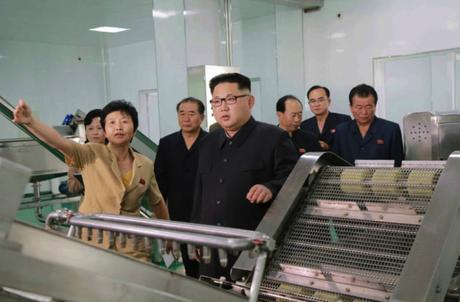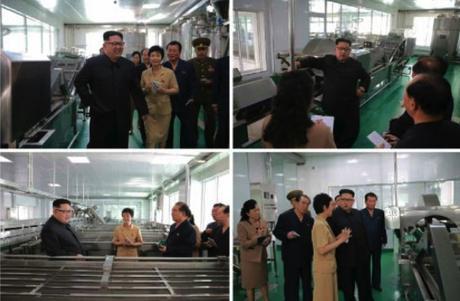
Kim Jong Un looks over production at the Ryugyo’ng Pickle Factory in suburban Pyongyang (Photo: Rodong Sinmun).
Kim Jong Un’s last observed appearance was his attendance at a KCU concert on June 7
DPRK state media reported on June 10 (Friday) that Kim Jong Un (Kim Cho’ng-u’n) visited and inspected the Ryugyo’ng Pickle Factory located in the Pyongyang suburbs. Also in attendance were O Su Yong (Workers’ Party of Korea [WPK] Vice Chairman for Economic Affairs, Member of the WPK Political Bureau, Member of the WPK Executive Policy Council and Director of the WPK Economic Affairs [policy] Department), An Jong Su (Director of the WPK Light Industry Department), Jo Yong Won (deputy director of the WPK Organization Guidance Department), Sin Man Gyun (deputy director of the WPK Light Industry Department) and Ma Won Chun (Director of the National Defense Commission [NDC] Design Department).
![Kim Jong Un Visits Ryugyong Pickle Factory Attending the inspection of the pickle factory were: WPK Light Industry Department Director An Jong Su [1], WPKLight Industry Department Deputy Director Sin Man Gyun [2], WPK Organization Guidance Department Deputy Director Jo Yong Won and WPK Vice Chairman and WPK Political Bureau Member O Su Yong (4)](https://m5.paperblog.com/i/149/1491257/kim-jong-un-visits-ryugyong-pickle-factory-L-jwFcW1.jpeg)
Attending the inspection of the pickle factory were: WPK Light Industry Department Director An Jong Su [1], WPKLight Industry Department Deputy Director Sin Man Gyun [2], WPK Organization Guidance Department Deputy Director Jo Yong Won and WPK Vice Chairman and WPK Political Bureau Member O Su Yong (4)
According to KCNA, the place is a “modern pickle production based built under the loving care of Kim Jong Un,” who “settled all the problems arising in the construction of the factory, noting that it was needed to build a modern pickle factory with a large capacity whose industrialization is put on a higher level in order to supply Pyongyang citizens with tasty pickles on a normal basis in all seasons he named it ‘Ryugyo’ng Pickle Factory.” The factory, according to KCNA and KCBS, has a total floor space of 15, 600 square meters (167, 917 square feet) and an annual production capacity for 4,200 tons of pickles.
Kim Jong Un inspects the Ryugyo’ng Picklet Factory (Photos: Rodong Sinmun/KCNA).
Jong Un toured different sections of the factory where he is briefed about its production and industrial equipment. He noted that the “production processes of whole cabbage kimchi, hot pickles of chopped radishes and pickling are furnished with modern equipment designed by our scientists and technicians and manufactured by our own efforts” and he highly appreciated “the fact that many successes were made in implementing the Party’s policy of locally producing whatever necessary.” He said that it is “the Party’s intention to build the Ryugyo’ng Pickle Factory into an icon and standard unit for the country’s industrial production of kimchi” and issued instructions to that effect.

Kim Jong Un inspects the Ryugyo’ng Pickle Factory (Photos: Rodong Sinmun).
He stressed “the need to build a modern pickle factory in each province on the basis of the experience gained from the construction of the Ryugyo’ng Pickle Factory.” He remarked that “kimchi is one of the Korean nation’s most favorite traditional dishes and it is well-known as one of the world’s five health foods” and he urged “the factory to make it more delicious than that produced by individual household and thus make it a favorite dish of the citizens and the best food in the world.”
Jong Un expressed his “conviction that the officials and employees of the factory would produce various kinds of fresh pickles with high nutritive value and peculiar taste to supply to the public catering establishments in the city of Pyongyang and its citizens and thus make a positive contribution to the improvement of people’s diets.”
Filed under: 200 Day Speed Battle (2016), 7th Party Congress, An Jong Su (WPK LID), Capital City Construction Commission, Central Committee, Comprehensive Affairs, critical infrastructure, DPRK Cabinet, Economic Complexes, Events Management Section, Executive Policy Bureau, Financial Planning Department, Five Year Economic Plan and Development Strategy (2016), food production, General Affairs, Guard Command, Jo Yong Won, Kim Chong-un inspections, Kim Family, Kim Jong Un Visits, Kim Jong-un, KJI Personal Secretariat, Korean People's Army (KPA), Korean People's Internal Security Forces, Korean Workers' Party (KWP), KPA construction battalions, KPA construction brigades, kpif, Light Industry Department, Ma Wo'n-ch'un (AD), Ministry of Food and Consumer Goods, Ministry of Food and Procurement, Ministry of Foodstuffs and Daily Necessities, ministry of people's security, Ministry of State Construction Control, Ministry of State Security, Ministry of the People's Armed Forces (MPAF), National Defense Commission (NDC), NDC Administration Department, North Korean press, Notification, O Su Yong, Organization and Guidance Department, Political Bureau, Provincial Party Committees, Provincial Party System, Pyongyang Defense Command, Sin Man Gyun (WPK LID), State Planning Commission (SPC), State Security Department
